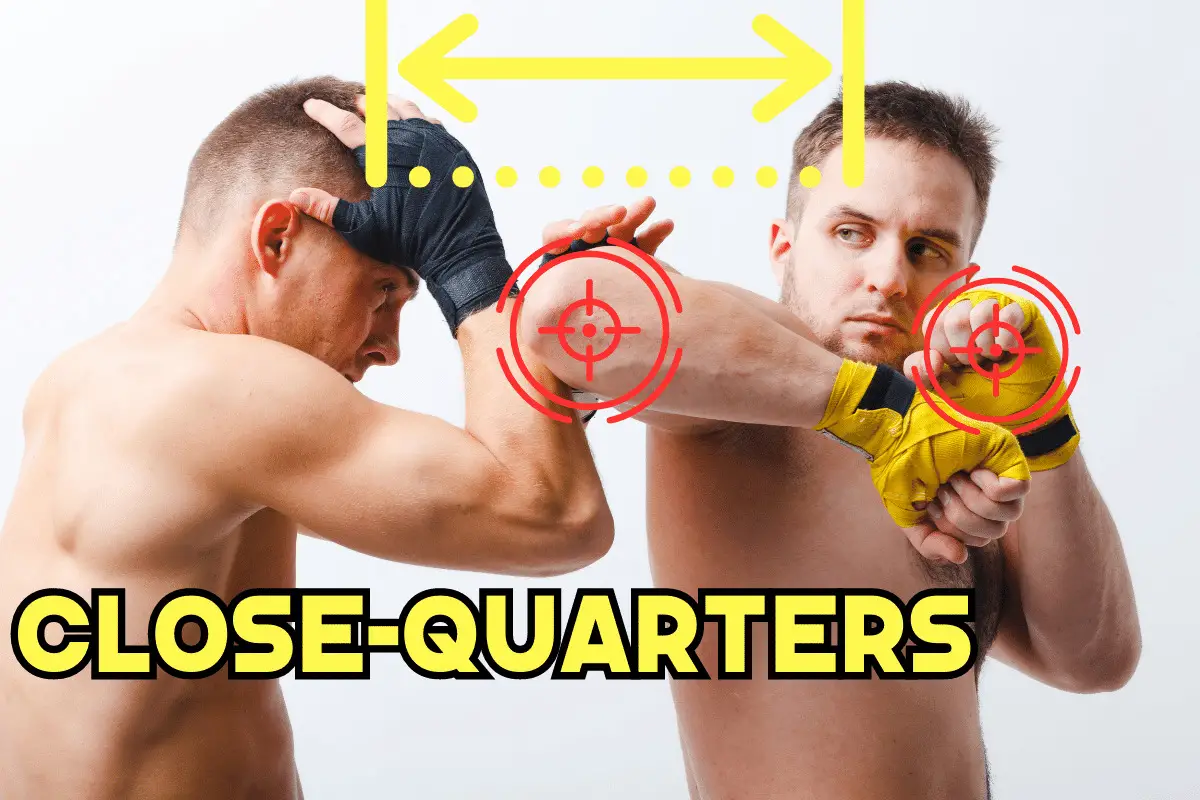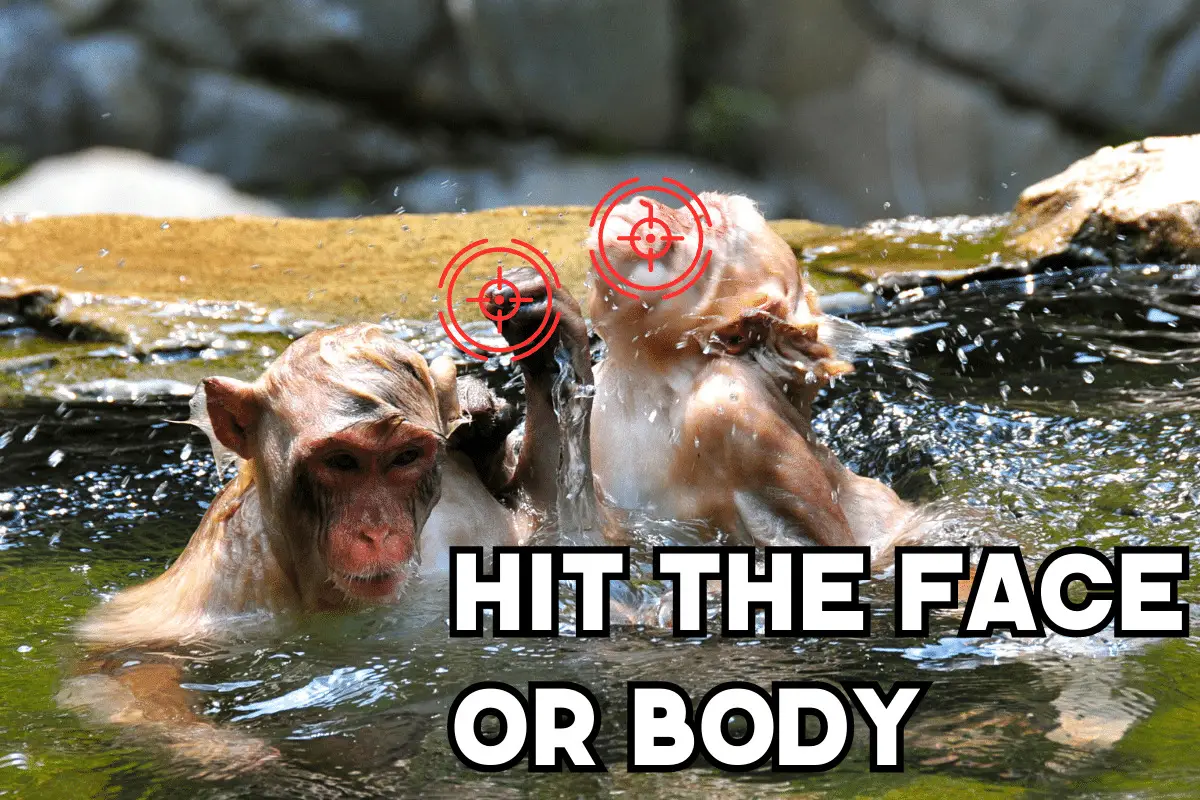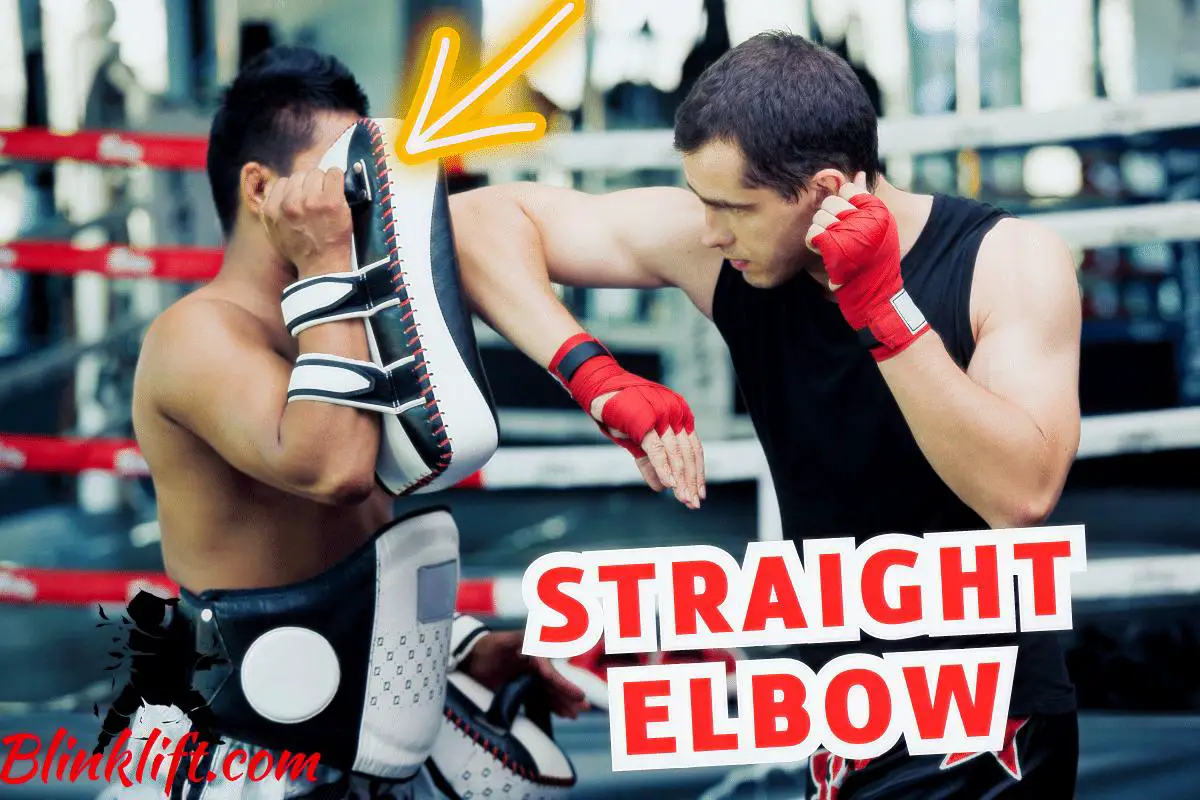So you want to learn the Straight Elbow; that’s excellent since you’re taking practical steps toward learning it, which is unlike many fighters out there. This article will not only provide you with everything you need to know to learn this elbow strike but also perfect it!
You’re definitely in the right place—at the right time. If you follow through with this article, you’ll be able to begin practicing the Straight Elbow. With enough effort and proper implementation of the things we’ll review, there’ll be nothing stopping you on your way to utter perfection.
In Muay Thai, the Straight Elbow refers to a technique where a fighter strikes their opponent using a straightened arm, delivering a powerful blow with the bony part of the elbow. This technique is known for its effectiveness in close-quarter combat and is a devastating weapon when executed correctly.
Indeed, it’s a close-quarter combat weapon, which won’t necessarily knock out your opponent but will cut and bruise him badly. It’s also suitable for inflicting massive amounts of pain, as you’ll be able to quickly thrust your elbow on your target, which isn’t a pleasant experience, to say the least.
We have plenty to cover. I think it’s time we dive into the first part (out of two) of this complete technique breakdown. So without further ado, let’s dive in!
How to Throw a Perfect Straight Elbow
The first part of this article will review how you can perform the Straight Elbow flawlessly. The second part will be about combinations, which is a major part of Muay Thai and fighting in general. By the way, you can follow the link in the last sentence to skip through to it.
So now, let us entirely focus on the points that will get you to elbow-strike perfection. What you’ll see is that perfection starts as early as in your fighting stance. So how you stand before you consider throwing the elbow—will greatly impact your strike—so you want to pay close attention to all the points.
I have a dedicated article on the traditional Muay Thai fighting stance and how to utilize it to generate more power, speed, and accuracy with your strikes. Follow the link to work on your fighting stance.
Let us dive into the first point! I wish you all the good luck in your journey—and let’s begin!
#1 – Stance
The first step in perfecting your elbow strike is honing your fighting stance. Indeed, the road toward generating more power and speed, and becoming a better fighter in all senses—starts with having a solid fighting stance that serves your goals.
Assume a proper Muay Thai fighting stance. Stand with your feet shoulder-width apart, one foot slightly ahead of the other. Keep your knees slightly bent, and your weight evenly distributed.
If you have never worked on your fighting stance before, I would urge you to follow this link to read a guide I wrote to perfect your Muay Thai fighting stance. If you’re serious about learning the Straight Elbow, this is the first part of doing so.
#2 – Close the Distance
The second point is to close the distance. The Straight Elbow is a close-quarter strike, making it much more effective from, well, close range. You won’t be able to (1) hit or (2) cause any significant damage—if you throw this elbow strike from long-range.
To execute a straight elbow strike, you need to be in close range to your opponent. Close the distance by stepping forward with your lead foot, closing the gap between you and your opponent.
We’ll later review how you can use footwork to help you close the distance and create a much larger impact with this strike.

#3 – Chamber the Elbow
The next point we’ll review is where most Muay Thai fighters go wrong. You must ensure you skip making this mistake, as it’ll be fatal on your way to learning and perfecting any strike, whether it’s a punch, kick, knee, or elbow strike.
The key to this point is to set up the Straight Elbow. You want to generate more power, which comes from “chambering the elbow” so to speak. You want to essentially bring your elbow toward your hip which in turn creates more momentum.
Bring your striking elbow back towards your hip, creating a compact and tight chamber. Your elbow should be close to your body, ready to launch forward.
The power generated in a straight elbow strike comes from the rotation of the hips and the transfer of weight from the back leg to the front leg. The fighter generates force by pushing off the back leg and pivoting on the front foot, allowing the entire body to contribute to the strike.
The momentum and torque generated from this motion are then transferred to the elbow, making it an incredibly powerful and destructive technique.

#4 – Cutting Motion
Let’s now talk about the actual motion you want to create with your elbow. To recap, thus far we reviewed three critical points: your fighting stance, which is how you begin – closing the distance, which is key to performing any elbow strike – and lastly, chambering the elbow, which is key in creating more power.
Now that you have that down, you can begin working on the motion you create with this Straight Elbow. The motion should be a cutting motion, that literally cuts through your target (we’ll discuss target selection in the following point.)
Drive your elbow forward, extending your arm explosively towards the target. Simultaneously, pivot your front foot and rotate your hips, generating power from the lower body. The power should come from the rotation of the hip and the transfer of weight from your back leg to your front leg.
Elbows aren’t knockout punches like the Hook or Uppercut. Rather, they serve as sharp and bony cutting machines, which will make your opponent regret waking up in the morning. So the fact that they’re not knockout strikes doesn’t mean you want to skip on learning them.
Get the motion right and you’ll be able to cause so much more damage with your elbows.
#5 – Target Selection
The next step is to choose a target for your elbow strike. This is critical to do before you execute it. Not only will it allow you to choose better targets, but it’ll also force you to observe your opponent and pay close attention to exposed parts you can hit.
Aim for your opponent’s head, face, chin, jaw, temple, or body, depending on the opening and opportunity presented. Make sure to maintain accuracy and precision in your strike.

#6 – Defense
After you’ve done all 5 steps and managed to hit the elbow, you’re not finished. You might have caused substantial damage to your opponent, but what if he’s now able to counter with a rear hook, catching you with your pants down?
After connecting with the elbow strike, maintain your balance and quickly retract your elbow back to the chamber position, ready to defend or throw another strike.
I always say this, but still, many Muay Thai fighters don’t care as much about defense as they do for the offense. Therefore, their opponents are able to catch them off-guard and counter, perhaps knocking them out in the process.
If you throw the perfect Straight Elbow but get hit with a hook right to the face in the process, was it worth it? I’ll say no. But, what if you were able to throw the perfect elbow strike and block the opponent’s offense? In that case, you got the upper hand in the fight together with the momentum. So you’re so much better off.
Make sure to prioritize defense as much as offense!
Now, let’s dive into the second part of the article, which isn’t less important than the first.
Straight Elbow Combinations (Muay Thai)
The second part of this article will cover ways you can incorporate the Straight Elbow with other offensive moves. If you don’t know what combinations are, they’re the bread and butter of causing massive damage quickly.
Think about what it would be like if you were to charge one strike at a time; you wouldn’t be able to cause any damage whatsoever. Therefore, what you do is combine techniques that in turn allow you to cause more damage and do so more quickly.
Here are some of my favorite combinations in Muay Thai that involve the Straight Elbow.
- Jab-Cross-Straight Elbow: Start with a standard jab (lead hand) followed by a cross (rear hand) to set up the distance and create an opening. Then, quickly transition into a straight elbow strike with your lead arm, aiming at your opponent’s head or face.
- Hook-Cross-Straight Elbow: Begin with a lead hook to the head or body, followed by a powerful cross with your rear hand. After delivering the cross, immediately transition into a straight elbow strike using your lead arm to exploit any openings created.
- Teep-Straight Elbow: Utilize a teep (push kick) to create distance and disrupt your opponent’s balance. As your opponent reacts and their guard lowers, seize the opportunity to drive a straight elbow strike using your lead arm.
- Clinch-Straight Elbow: In the clinch, where fighters are in close quarters, you can utilize the straight elbow strike effectively. While maintaining control of your opponent’s neck or arms in the clinch, launch a straight elbow strike with your lead arm toward their head or body.
- Elbow Combination: Combine multiple elbow strikes together to create a devastating combination. For instance, you can throw a lead diagonal elbow strike (slicing elbow) followed by a rear horizontal elbow strike (swinging elbow) and finish with a straight elbow strike from the lead arm.
Final Words
So this was the Straight Elbow. It’s one of the most devastating strikes in Muay Thai, which you can also use in street fights and self-defense to cause massive damage quickly while closing the distance.
Indeed, it’s more of a close-range strike, as you can imagine. Therefore, you must pay attention before you perform it, as it’ll leave you more vulnerable than you want to be.
If you found this article helpful, you’d also benefit from reading about the best types of punches in Muay Thai and how to execute each one. Follow the link to read it!
Here are other articles you’d enjoy reading:

